Improved Aerosol Optical Thickness, Columnar Water Vapor, and Surface Reflectance Retrieval from Combined CASI and SASI Airborne Hyperspectral Sensors
Abstract
:1. Introduction
- (1)
- Integrating separate VNIR and SWIR modules from airborne CASI-1500 and SASI-600 data collected from test sites in China;
- (2)
- Automatically retrieving AOT, CWV and surface reflectance; and
- (3)
- Improving the accuracy of the reflectances.
2. Study Area and Data Acquisition
2.1. Study Area
2.2. Airborne Data
2.3. Field Measurement
3. Methodology and Algorithm Employed
- (1)
- Radiometric and spatial cross-calibration of the CASI VNIR and SASI SWIR module data;
- (2)
- Establishing AOT@550 nm-related relationships between 465.6-nm/659-nm and 2105-nm wavelengths from the CASI and SASI data, and improving the minimization of the merit function;
- (3)
- Estimating pixel-based CWV by initially using the CIBR method, and then by refining the CWV using SODA;
- (4)
- Applying Powell’s method to establish optimal pairing of AOT and CWV (Powell’s method is highly effective and robust for finding the optimal value); and
- (5)
- Validating the airborne results using the available ground-based reflectance data.
3.1. Integration of Separate CASI and SASI Sensors
3.2. Theoretical Background of Atmospheric Correction
3.3. Design of the Look-Up Table
- (1)
- Model Atmosphere Selection: Mid-Latitude Summer (45° North Latitude); atmospheric path is slant path; CO2 mixing ratio is 360.0 ppmv; multiple scattering parameter is Distort and number of Distort stream equals to 8; the temperature at first boundary is based on the atmospheric temperature observed simultaneously at near-surface.
- (2)
- Aerosol and Cloud Option: Aerosol model is set to RURAL extinction, default VIS = 5 km; seasonal aerosol profile (ISEASN) is set to SPRING-SUMMER; the wind speed is set to the value measured simultaneously at near-surface; the weather is fine, and there is no cloud or rain.
- (3)
- Flight height = 1 km.
3.4. Retrieval of Aerosol Optical Thickness
3.5. Retrieval of Columnar Water Vapor
3.6. Retrieval of Land Surface Reflectance
4. Results and Analysis
4.1. Analysis of CWV Accuracy
4.2. Analysis of Surface Reflectance Accuracy
5. Conclusions
Acknowledgments
Author Contributions
Conflicts of Interest
References
- Goetz, A.F.H. Three decades of hyperspectral remote sensing of the Earth: A personal view. Remote Sens. Environ. 2009, 113, S5–S16. [Google Scholar] [CrossRef]
- Tong, Q.; Xue, Y.; Zhang, L. Progress in hyperspectral remote sensing science and technology in China over the past three decades. IEEE J. Sel. Top. Appl. Earth Obs. Remote Sens. 2014, 7, 70–91. [Google Scholar] [CrossRef]
- Farrand, W.H.; Singer, R.B.; Merényi, E. Retrieval of apparent surface reflectance from AVIRIS data: A comparison of empirical line, radiative transfer, and spectral mixture methods. Remote Sens. Environ. 1994, 47, 311–321. [Google Scholar] [CrossRef]
- Kruse, F.A. Use of airborne imaging spectrometer data to map minerals associated with hydrothermally altered rocks in the northern Grapevine Mountains, Nevada, and California. Remote Sens. Environ. 1988, 24, 31–51. [Google Scholar] [CrossRef]
- Goetz, A.F.; Srivastava, V. Mineralogical Mapping in the Cuprite Mining District, Nevada. Available online: https://ntrs.nasa.gov/search.jsp?R=19860002152 (accessed on 23 November 2016).
- Vermote, E.F.; Tanre, D. Second simulation of the satellite signal in the solar spectrum, 6S: An overview. IEEE Trans. Geosci. Remote Sens. 1997, 35, 675–686. [Google Scholar] [CrossRef]
- Guanter, L.; Richter, R.; Kaufmann, H. On the application of the MODTRAN4 atmospheric radiative transfer code to optical remote sensing. Int. J. Remote Sens. 2009, 30, 1407–1424. [Google Scholar] [CrossRef]
- Berk, A. MODTRAN4 User’s Manual; Air Force Research Laboratory, Space Vehicles Directorate: Hanscom Air Force Base, MA, USA, 1999; pp. 1–5. [Google Scholar]
- Sismanidis, P.; Karathanassi, V. Evaluation of atmospheric correction to airborne hyperspectral data relying on radiative transfer concepts. Int. J. Remote Sens. 2013, 34, 8566–8587. [Google Scholar] [CrossRef]
- Gao, B.-C. Atmospheric correction algorithms for hyperspectral remote sensing data of land and ocean. Remote Sens. Environ. 2009, 113, S17–S24. [Google Scholar] [CrossRef]
- Kaufman, Y.; Tanré, D.; Remer, L.A.; Vermote, E.F.; Chu, A.; Holben, B.N. Operational remote sensing of tropospheric aerosol over land from EOS moderate resolution imaging spectroradiometer. J. Geophys. Res. Atmos. 1997, 102, 17051–17067. [Google Scholar] [CrossRef]
- Kaufman, Y.J. The MODIS 2.1-μm channel-correlation with visible reflectance for use in remote sensing of aerosol. IEEE Trans. Geosci. Remote Sens. 1997, 35, 1286–1298. [Google Scholar]
- Schläpfer, D. Atmospheric Precorrected Differential Absorption Technique to Retrieve Columnar Water Vapor. Remote Sens. Environ. 1998, 65, 353–366. [Google Scholar] [CrossRef]
- Bojinski, S. Aerosol mapping over land with imaging spectroscopy using spectral autocorrelation. Int. J. Remote Sens. 2004, 25, 5025–5047. [Google Scholar] [CrossRef]
- Zhao, X.; Liang, S.L.; Liu, S.H.; Wang, J.D.; Qin, J.; Li, Q.; Li, X.W. Improvement of dark object method in atmospheric correction of hyperspectral remotely sensed data. Sci. China Ser. D Earth Sci. 2008, 51, 349–356. [Google Scholar] [CrossRef]
- Gao, B.-C.; Kaufman, Y.J. Water vapor retrievals using Moderate Resolution Imaging Spectroradiometer (MODIS) near-infrared channels. J. Geophys. Res. 2003, 108, 4389. [Google Scholar] [CrossRef]
- Guanter, L.; Alonso, L.; Moreno, J. A method for the surface reflectance retrieval from PROBA/CHRIS data over land: Application to ESA SPARC campaigns. IEEE Trans. Geosci. Remote Sens. 2005, 43, 2908–2917. [Google Scholar] [CrossRef]
- Rodger, A. SODA: A new method of in-scene atmospheric water vapor estimation and post-flight spectral recalibration for hyperspectral sensors: Application to the HyMap sensor at two locations. Remote Sens. Environ. 2011, 115, 536–547. [Google Scholar] [CrossRef]
- Gao, B.-C.; Goetz, A.F.H. Determination of total column water vapor in the atmosphere at high spatial resolution from AVIRIS data using spectral curve fitting and band ratioing techniques. Imaging Spectrosc. Terr. Environ. 1990, 1298. [Google Scholar] [CrossRef]
- Gao, B.C.; Goetz, A.F. Column atmospheric water vapor and vegetation liquid water retrievals from airborne imaging spectrometer data. J. Geophys. Res. Atmos. 1990, 95, 3549–3564. [Google Scholar] [CrossRef]
- Guanter, L.; Estellés, V.; Moreno, J. Spectral calibration and atmospheric correction of ultra-fine spectral and spatial resolution remote sensing data. Application to CASI-1500 data. Remote Sens. Environ. 2007, 109, 54–65. [Google Scholar] [CrossRef]
- Remer, L.A. The MODIS aerosol algorithm, products, and validation. J. Atmos. Sci. 2005, 62, 947–973. [Google Scholar] [CrossRef]
- Levy, R.C.; Remer, L.A.; Kaufman, Y.J. Effects of neglecting polarization on the MODIS aerosol retrieval over land. IEEE Trans. Geosci. Remote Sens. 2004, 42, 2576–2583. [Google Scholar] [CrossRef]
- Levy, R.C.; Remer, L.A.; Mattoo, S.; Vermote, E.F.; Kaufman, Y.J. Second-generation operational algorithm: Retrieval of aerosol properties over land from inversion of Moderate Resolution Imaging Spectroradiometer spectral reflectance. J. Geophys. Res. Atmos. 2007, 112, D13211. [Google Scholar] [CrossRef]
- Guanter, L. New Algorithms for Atmospheric Correction and Retrieval of Biophysical Parameters in Earth Observation: Application to ENVISAT/MERIS Data. Available online: http://roderic.uv.es/handle/10550/15793 (accessed on 23 November 2016).
- Guanter, L.; Gómez-Chova, L.; Moreno, J. Coupled retrieval of aerosol optical thickness, columnar water vapor and surface reflectance maps from ENVISAT/MERIS data over land. Remote Sens. Environ. 2008, 112, 2898–2913. [Google Scholar] [CrossRef]
- Hsu, N.C.; Tsay, S.-H.; King, M.D.; Herman, J.R. Aerosol properties over bright-reflecting source regions. IEEE Trans. Geosci Remote Sens. 2004, 42, 557–569. [Google Scholar] [CrossRef]
- Hsu, N.C. Deep blue retrievals of Asian aerosol properties during ACE-Asia. IEEE Trans. Geosci. Remote Sens. 2006, 44, 3180–3195. [Google Scholar] [CrossRef]
- Bassani, C.; Cavalli, R.M.; Pignatti, S. Aerosol optical retrieval and surface reflectance from airborne remote sensing data over land. Sensors 2010, 10, 6421–6438. [Google Scholar] [CrossRef] [PubMed]
- Frouin, R.; Deschamps, P.-Y.; Lecomte, P. Determination from space of atmospheric total water vapor amounts by differential absorption near 940 nm: Theory and airborne verification. J. Appl. Meteorol. 1990, 29, 448–460. [Google Scholar] [CrossRef]
- Green, R.; Carrere, V.; Conel, J. Measurement of atmospheric water vapor using the Airborne Visible/Infrared Imaging Spectrometer. In Proceedings of the Workshop Imaging Processing, Sparks, NV, USA, 23 May 1989.
- Bruegge, C.J. In-situ atmospheric water-vapor retrieval in support of AVIRIS validation. Proc. SPIE 1990, 1298. [Google Scholar] [CrossRef]
- Bruegge, C.J. Water vapor column abundance retrievals during FIFE. J. Geophys Res. Atmos. 1992, 97, 18759–18768. [Google Scholar] [CrossRef]
- Schläpfer, D.; Keller, J.; Itten, K. Imaging Spectrometry of Tropospheric Ozone and Water Vapor; A.A. Balkema: Rotterdam, The Netherlands, 1996; pp. 439–446. [Google Scholar]
- Carrère, V.; Conel, J.E. Recovery of atmospheric water vapor total column abundance from imaging spectrometer data around 940 nm—Sensitivity analysis and application to airborne visible/infrared imaging spectrometer (AVIRIS) data. Remote Sens. Environ. 1993, 44, 179–204. [Google Scholar] [CrossRef]
- Hu, S. Integrated Retrieval technique for Surface Reflectance from Spaceborne Hyperspectral Data. Ph.D. Thesis, Chinese Academy of Sciences, Beijing, China, 2013. [Google Scholar]
- Richter, R.; Schläpfer, D.; Müller, A. An automatic atmospheric correction algorithm for visible/NIR imagery. Int. J. Remote Sens. 2006, 27, 2077–2085. [Google Scholar] [CrossRef]
- Schläpfer, D.; Richter, R. Geo-atmospheric processing of airborne imaging spectrometry data. Part 1: parametric orthorectification. Int. J. Remote Sens. 2002, 23, 2609–2630. [Google Scholar] [CrossRef]
- Richter, R.; Schläpfer, D. Geo-atmospheric processing of airborne imaging spectrometry data. Part 2: atmospheric/topographic correction. Int. J. Remote Sens. 2002, 23, 2631–2649. [Google Scholar]
- Richter, R. A fast atmospheric correction algorithm applied to Landsat TM images. Remote Sens. 1990, 11, 159–166. [Google Scholar] [CrossRef]
- Hu, S.; She, X.; Tong, Q. Design and interpolation of a general look-up table for remote sensing image atmospheric correction. J. Remote Sens. 2014, 18, 45–60. [Google Scholar]
- Chylek, P.; Borel, C.C.; Clodius, W.; Pope, P.A.; Rodger, A.P. Satellite-based columnar water vapor retrieval with the multi-spectral thermal imager (MTI). Geosci. IEEE Trans. Remote Sens. 2003, 41, 2767–2770. [Google Scholar] [CrossRef]
- Bennartz, R.; Fischer, J. Retrieval of columnar water vapour over land from backscattered solar radiation using the Medium Resolution Imaging Spectrometer. Remote Sens. Environ. 2001, 78, 274–283. [Google Scholar] [CrossRef]
- Qu, Z.; Kindel, B.C.; Goetz, A.F. The high accuracy atmospheric correction for hyperspectral data (HATCH) model. IEEE Trans. Geosci Remote Sens 2003, 41, 1223–1231. [Google Scholar]
- Gao, B.-C.; Heidebrecht, K.B.; Goetz, A.F. Derivation of scaled surface reflectances from AVIRIS data. Remote Sens. Environ. 1993, 44, 165–178. [Google Scholar] [CrossRef]
- Guanter, L.; Richter, R.; Moreno, J. Spectral calibration of hyperspectral imagery using atmospheric absorption features. Appl. Opt. 2006, 45, 2360–2370. [Google Scholar] [CrossRef] [PubMed]
- Adler-Golden, S.M. Atmospheric correction for shortwave spectral imagery based on MODTRAN4. Proc. SPIE 1999, 3753, 61–69. [Google Scholar]
- Gao, B.-C.; Liu, M.; Davis, C.O. A new and fast method for smoothing spectral imaging data. In Summaries of the Seventh JPL Airborne Earth Science Workshop; AVIRIS Workshop: Pasadena, CA, USA, 1998. [Google Scholar]
- Joseph, B. Leveraging the high dimensionality of AVIRIS data for improved subQpixel target unmixing and rejection of false positives: mixure tuned matched filtering. In Summaries of the Seventh Annual JPL Airborne Geoscience Workshop; AVIRIS Workshop: Pasadena, CA, USA, 1998. [Google Scholar]
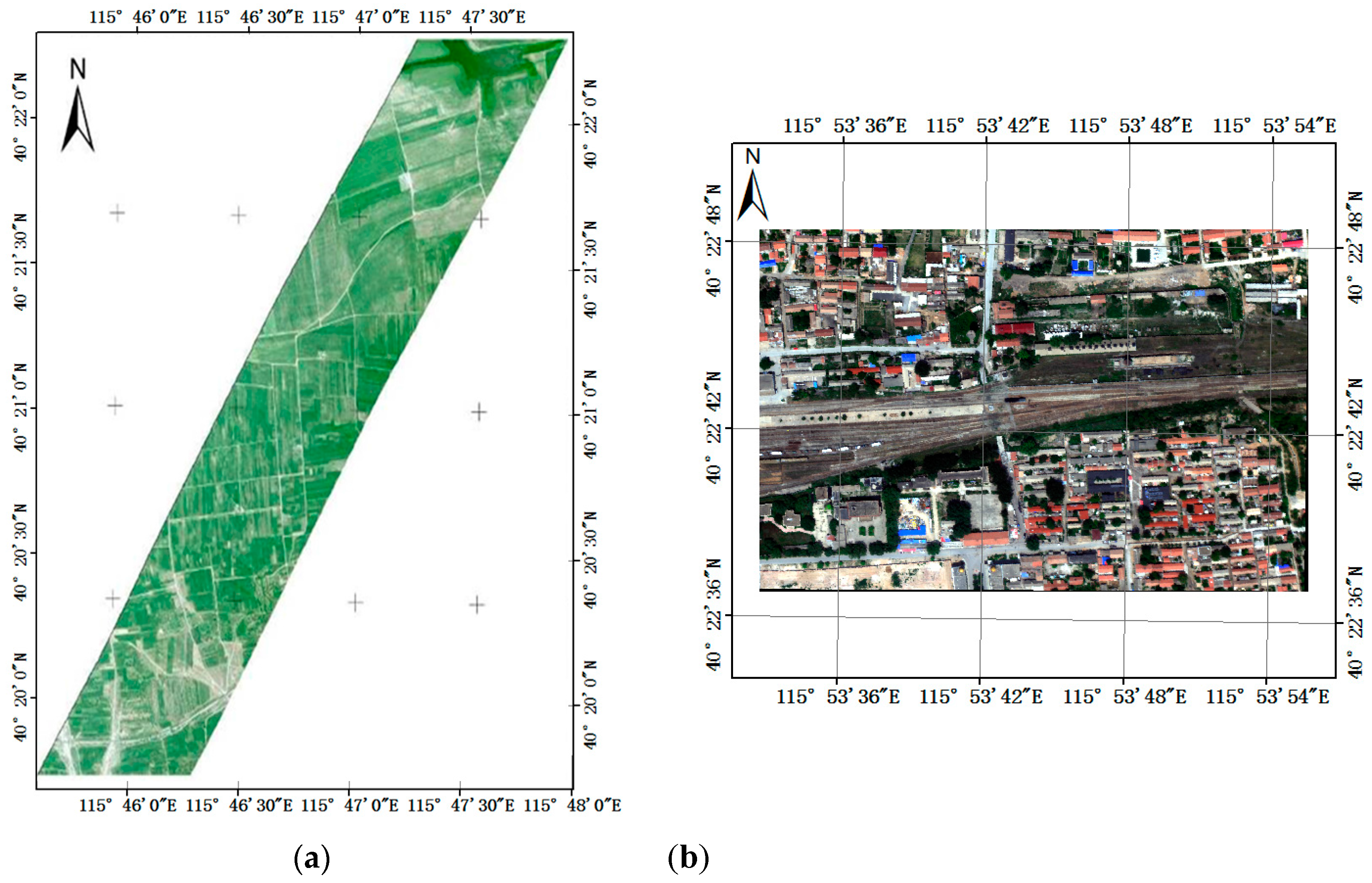
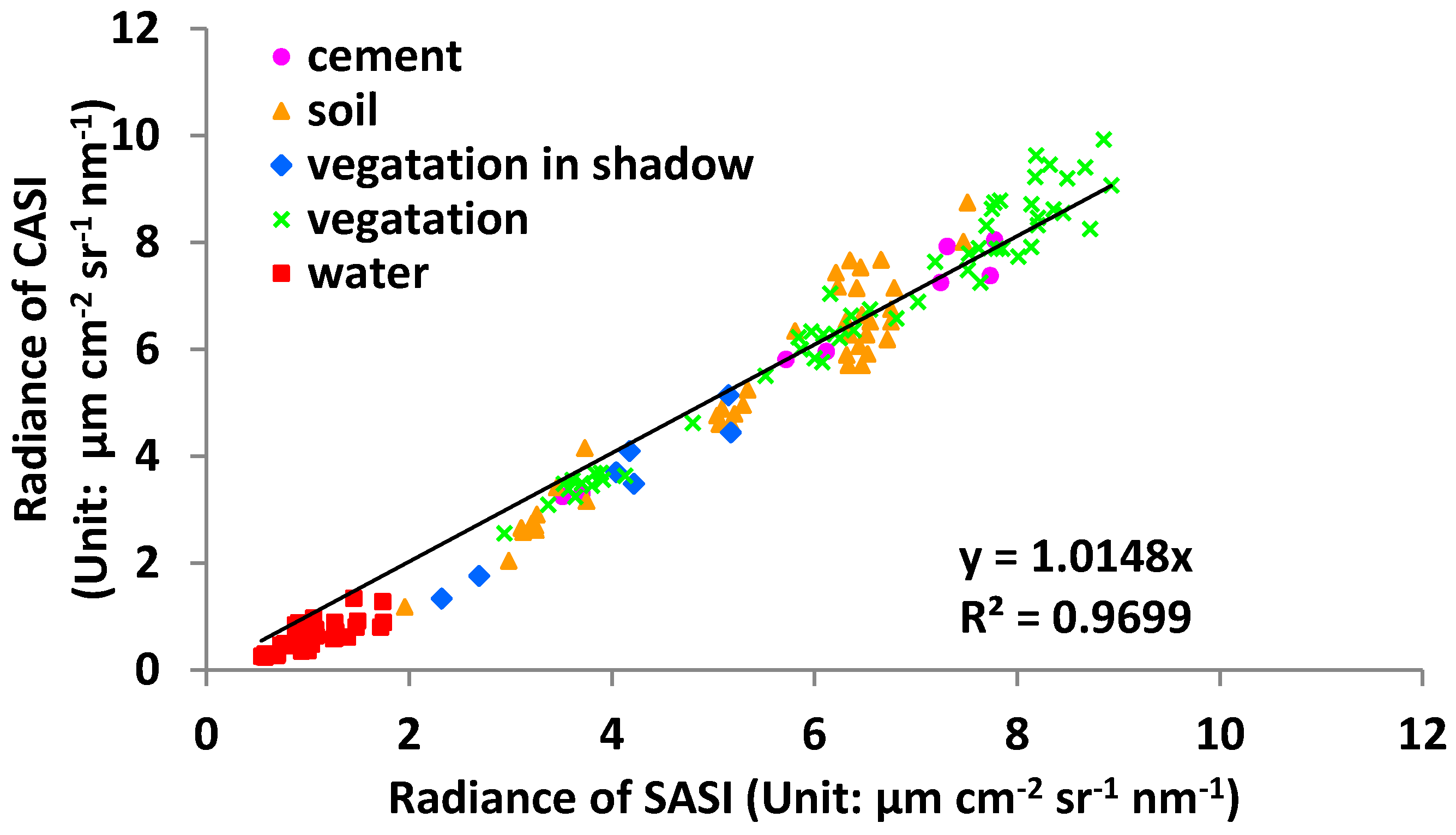


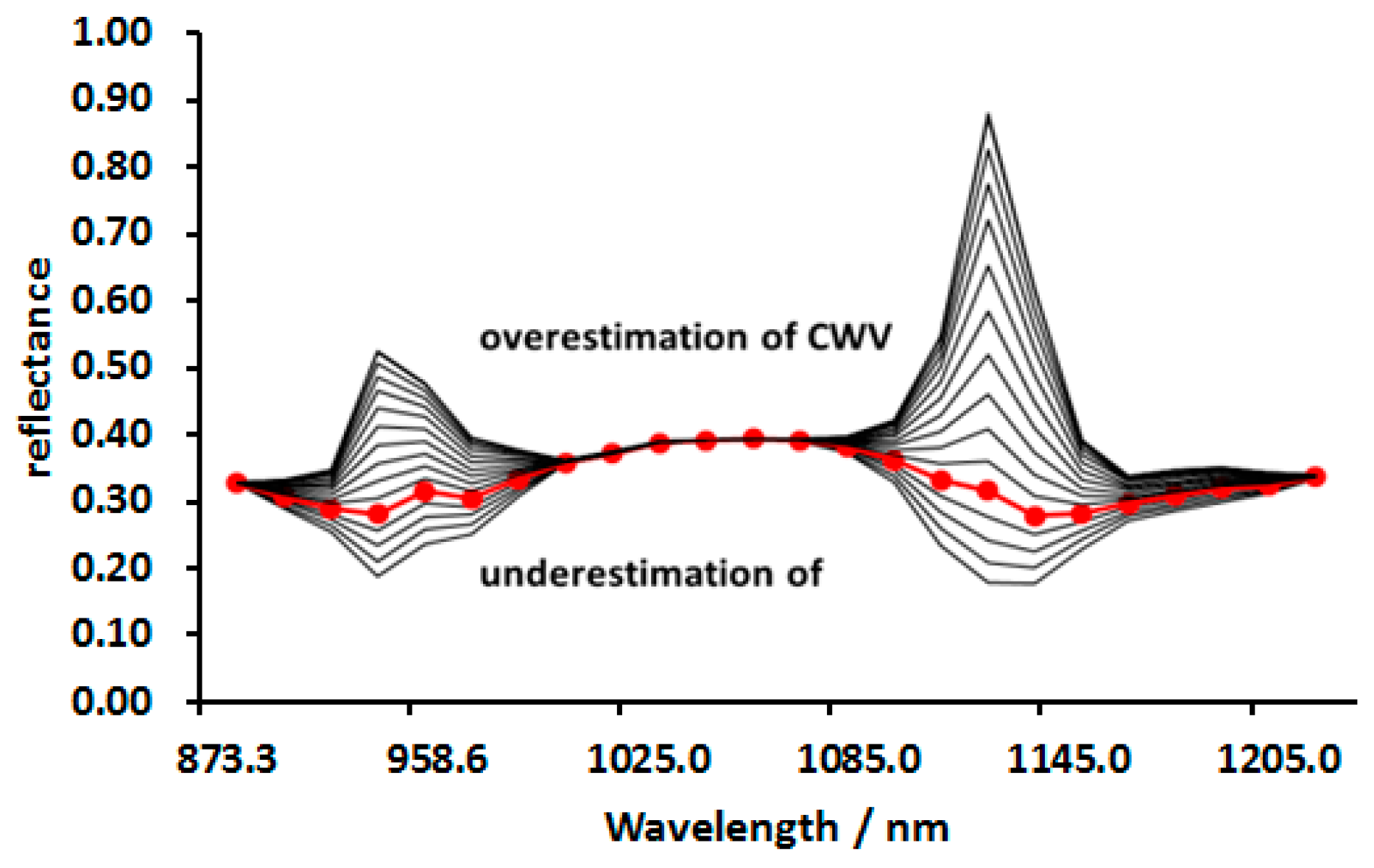
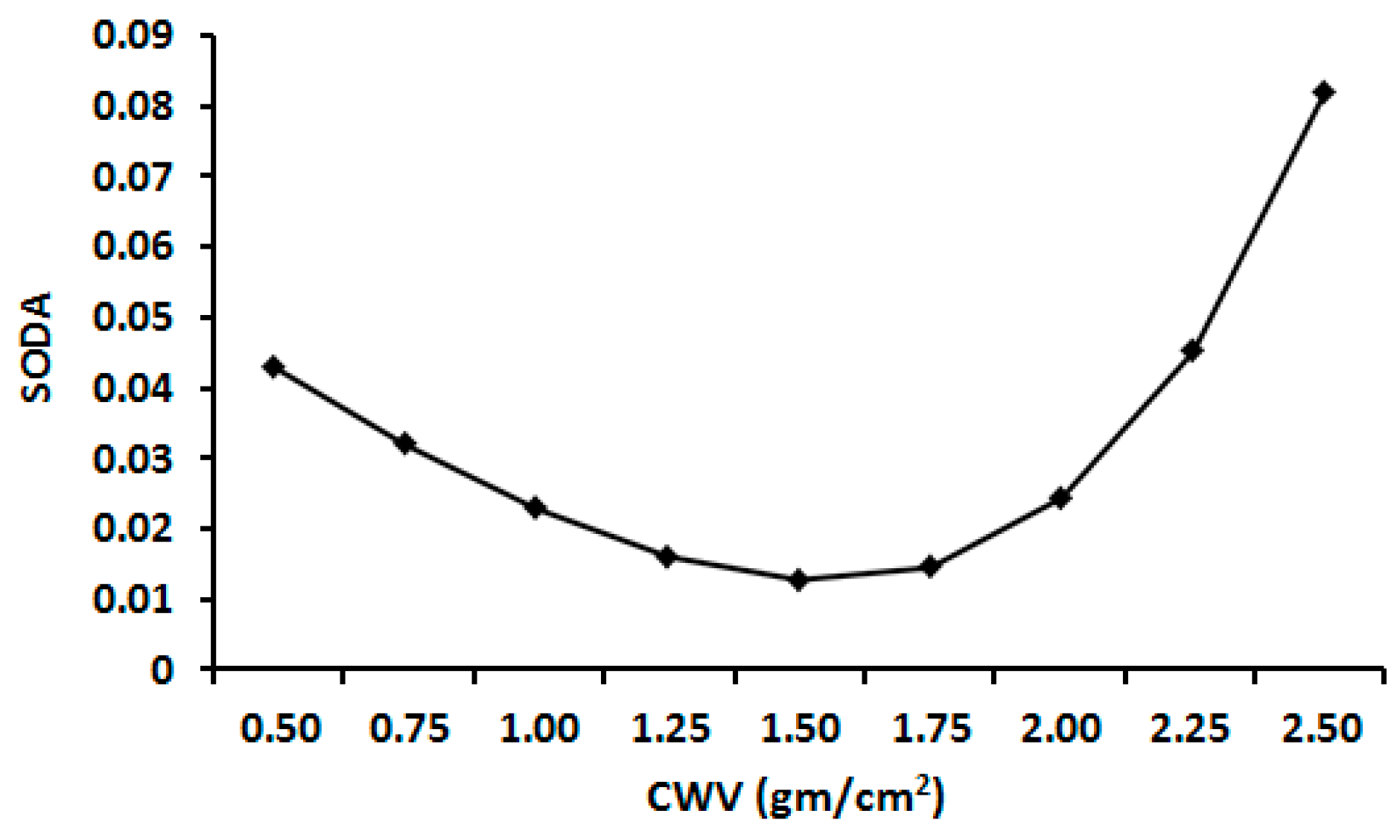

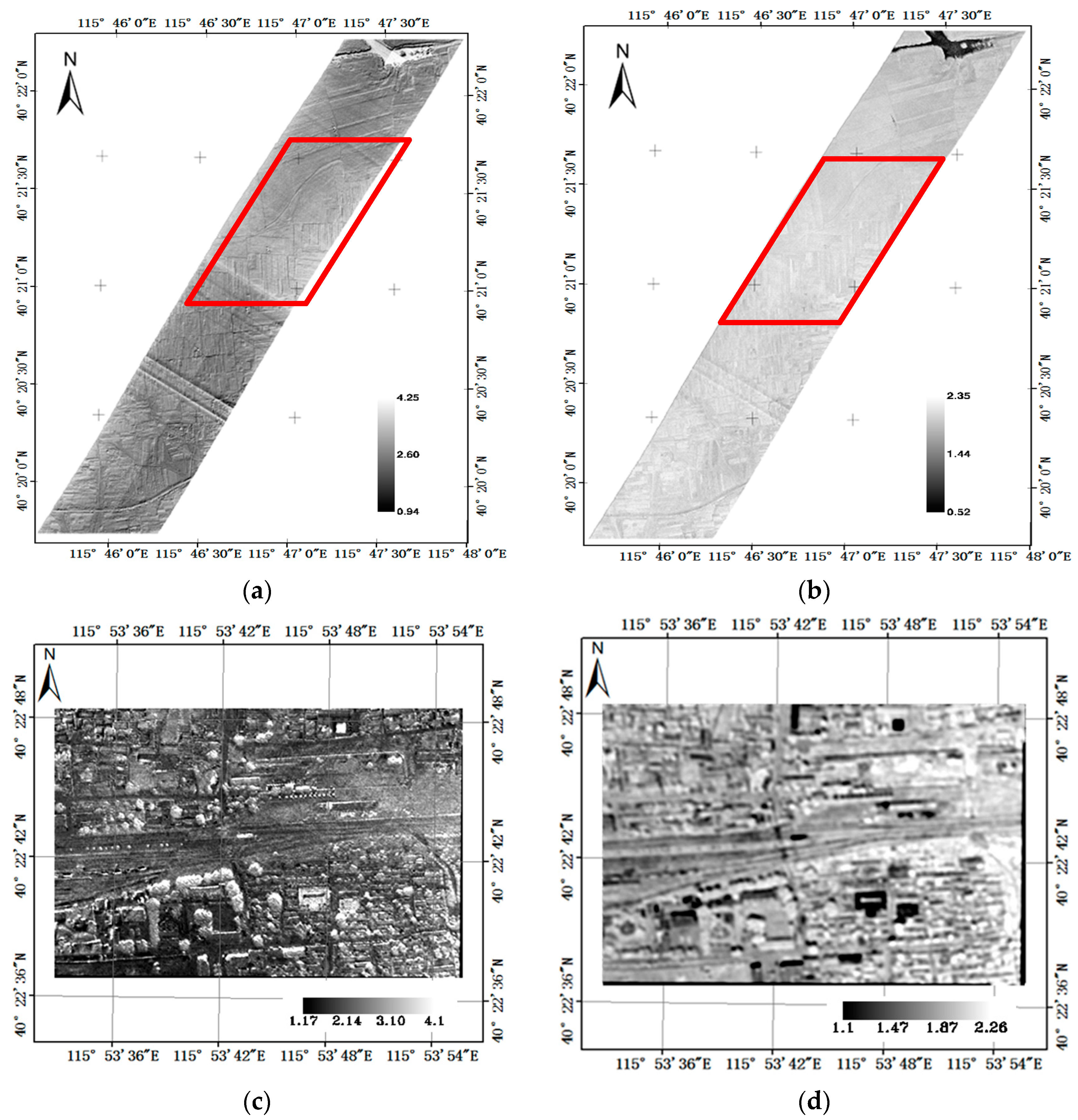
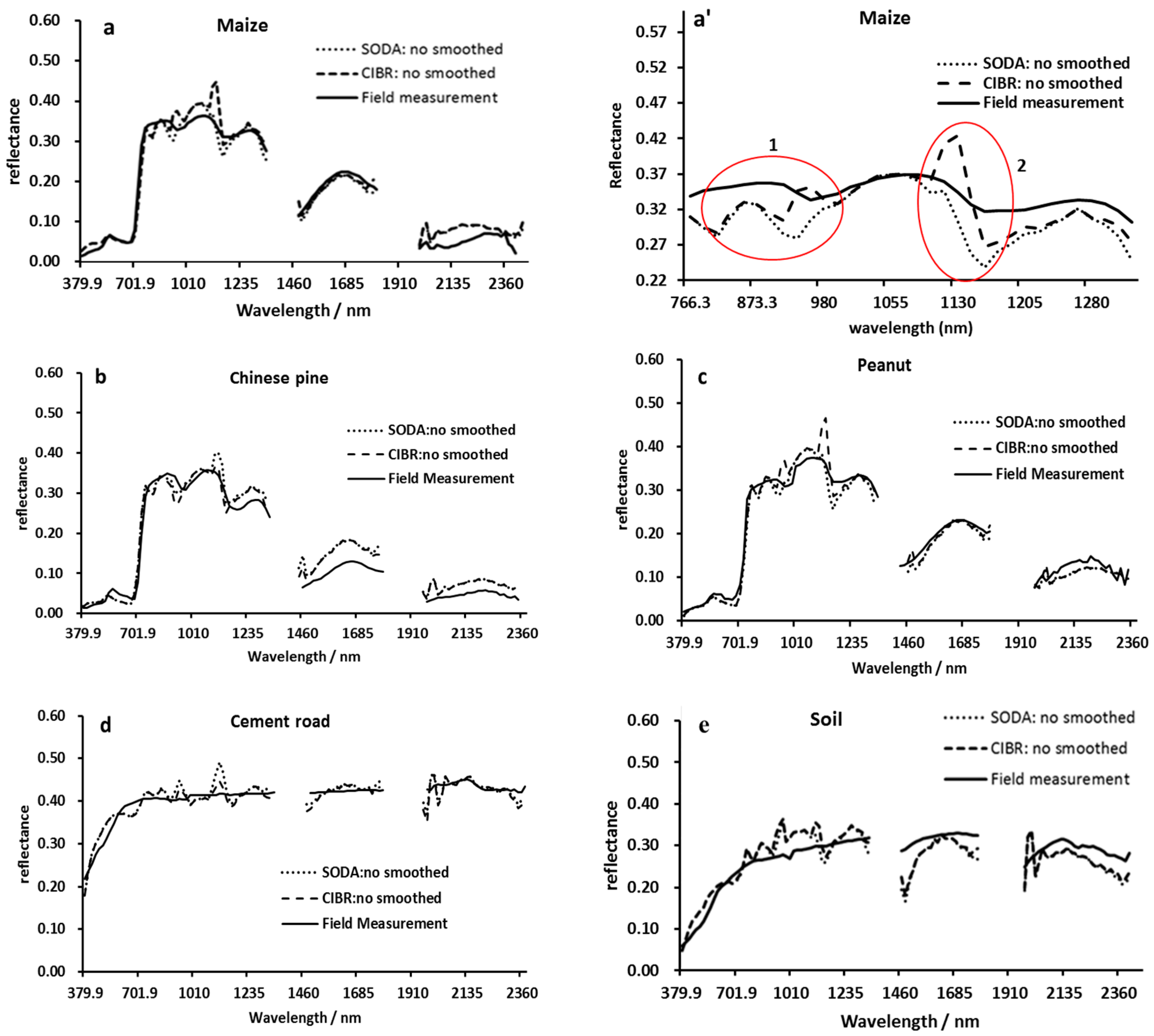
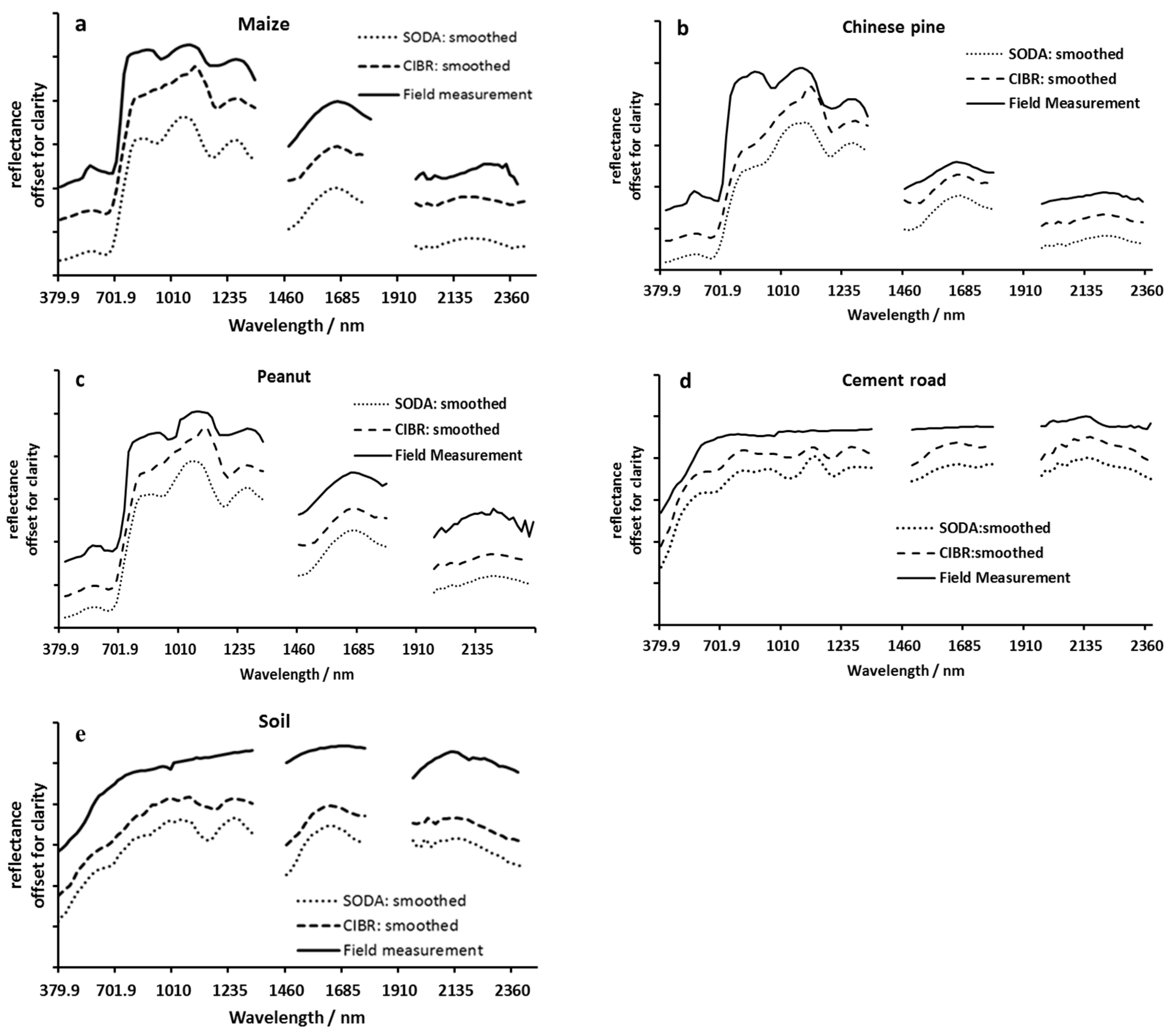
| Basic Specification | CASI-1500 | SASI-600 |
|---|---|---|
| Spectral range/(nm) | 380–1050 | 950–2450 |
| SPECTRAL SAMPLES | 32 * | 101 |
| FWHM/(nm) | 10.7 | 7.5 |
| SIGNAL TO NOISE RATIO * | 1095:1 peak | >1000 |
| FIELD OF VIEW/° | 40° | 40° |
| IFOV/mrad | 0.49 | 1.225 |
| Pixels/Across-Track | 1500 pixels | 600 pixels |
| NOISE FLOOR | <2.0 DN | 6.0 DN |
| Quantitative value/bit | 14 | 14 |
| No. | SZA (°) | RAA (°) | ELEV (km) | AOT | CWV (gm/cm2) |
|---|---|---|---|---|---|
| 1 | 0 | 0 | 0 | 0.05 | 0.50 |
| 2 | 10 | 25 | 0.7 | 0.10 | 0.75 |
| 3 | 20 | 50 | 1.5 | 0.15 | 1.00 |
| 4 | 30 | 75 | 2.5 | 0.20 | 1.25 |
| 5 | 40 | 100 | 0.25 | 1.50 | |
| 6 | 50 | 125 | 0.30 | 1.75 | |
| 7 | 60 | 150 | 0.35 | 2.00 | |
| 8 | 180 | 0.45 | 2.25 | ||
| 9 | 0.50 | 2.50 | |||
| 10 | 0.55 | 2.75 | |||
| 11 | 0.60 | 3.00 | |||
| 12 | 0.65 | 3.25 | |||
| 13 | 0.70 | 3.50 | |||
| 14 | 0.80 | 3.75 | |||
| 15 | 4.00 |
| MOD05 | CIBR | SODA | |
|---|---|---|---|
| 1 | 3.233626 | 2.240634 | 1.563913 |
| 2 | 3.267766 | 2.410114 | 1.638526 |
| 3 | 3.267029 | 2.366965 | 1.643027 |
| 4 | 3.249835 | 2.279332 | 1.630543 |
| R2 with MOD05 | 0.9152 | 0.8409 |
| Surface Type | R2 | RMSE | |
|---|---|---|---|
| Maize | not smoothed | 0.945 | 0.0252 |
| Maize | smoothed | 0.974 | 0.0247 |
| Peanut | not smoothed | 0.972 | 0.0192 |
| Peanut | smoothed | 0.982 | 0.0177 |
| Chinese pine | not smoothed | 0.893 | 0.0411 |
| Chinese pine | smoothed | 0.895 | 0.0404 |
| Cement road | not smoothed | 0.832 | 0.0211 |
| Cement road | smoothed | 0.908 | 0.0141 |
| Soil | not smoothed | 0.786 | 0.0356 |
| Soil | smoothed | 0.801 | 0.0317 |
© 2017 by the authors. Licensee MDPI, Basel, Switzerland. This article is an open access article distributed under the terms and conditions of the Creative Commons Attribution (CC BY) license ( http://creativecommons.org/licenses/by/4.0/).
Share and Cite
Yang, H.; Zhang, L.; Ong, C.; Rodger, A.; Liu, J.; Sun, X.; Zhang, H.; Jian, X.; Tong, Q. Improved Aerosol Optical Thickness, Columnar Water Vapor, and Surface Reflectance Retrieval from Combined CASI and SASI Airborne Hyperspectral Sensors. Remote Sens. 2017, 9, 217. https://doi.org/10.3390/rs9030217
Yang H, Zhang L, Ong C, Rodger A, Liu J, Sun X, Zhang H, Jian X, Tong Q. Improved Aerosol Optical Thickness, Columnar Water Vapor, and Surface Reflectance Retrieval from Combined CASI and SASI Airborne Hyperspectral Sensors. Remote Sensing. 2017; 9(3):217. https://doi.org/10.3390/rs9030217
Chicago/Turabian StyleYang, Hang, Lifu Zhang, Cindy Ong, Andrew Rodger, Jia Liu, Xuejian Sun, Hongming Zhang, Xun Jian, and Qingxi Tong. 2017. "Improved Aerosol Optical Thickness, Columnar Water Vapor, and Surface Reflectance Retrieval from Combined CASI and SASI Airborne Hyperspectral Sensors" Remote Sensing 9, no. 3: 217. https://doi.org/10.3390/rs9030217







